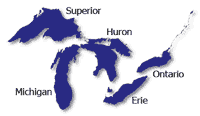 The
Great Lakes -
Superior,
Michigan,
Huron,
Erie,
and Ontario -
form the largest surface freshwater system on the Earth. More than
30 million people live in the Great Lakes basin, and the daily
activities of these people, from the water consumed to the waste
returned, directly affects the Great Lakes environment.
The
Great Lakes -
Superior,
Michigan,
Huron,
Erie,
and Ontario -
form the largest surface freshwater system on the Earth. More than
30 million people live in the Great Lakes basin, and the daily
activities of these people, from the water consumed to the waste
returned, directly affects the Great Lakes environment.
In May 2004, a Presidential Executive Order was
signed recognizing the Great Lakes as a national treasure, calling for the
creation of a "Regional Collaboration of
National Significance
![]() ,"
and a cabinet-level federal
Great Lakes Interagency
Task Force.
,"
and a cabinet-level federal
Great Lakes Interagency
Task Force.
The U.S.- Canadian Great Lakes Binational Toxics Strategy marked its 10th anniversary with its annual report. To date, 12 of the 17 goals for source- and emissions-reductions set in 1997 have been met, and the rest are well advanced. News release. Read the report.
The Great Lakes Legacy Act provides funding to take the necessary steps to clean up contaminated sediment in "Areas of Concern" (AOCs) located wholly or partially in the United States. Forty-three AOCs have been identified: 26 located entirely within the United States; 12 located wholly within Canada; and five that are shared by both countries.
The United States and Canada together assess the ecological health of the Great Lakes ecosystem and follow the trends of Great Lakes ecosystem conditions. /State of the Lakes Ecosystem/
 This
site provides information about efforts to keep the lakes clean
for the people, animals, and plants that depend on them.
This
site provides information about efforts to keep the lakes clean
for the people, animals, and plants that depend on them.
Great Lakes Restoration Initiative
The President's 2010 Budget provides $475 million for a new Environmental Protection Agency-led, interagency Great Lakes restoration initiative /more/
Great Lakes Topics
Areas of Concern
(AOCs)
Contaminated Sediments Program
Earth Day Challenge
Ecosystems
Environmental Indicators
Funding Program
Great Lakes Atlas
Great Lakes Binational Toxics Strategy
(GLTBS)
Great
Lakes Ecosystem Report
Great Lakes Water Quality Agreement
(GLWQA)
Human Health Program
Invasive Species
Lakewide Management Plans
2008 LaMPs:
Superior,
Michigan,
Huron,
Erie,
Ontario
Monitoring Program
Other Topics of Interest
About the Great Lakes
Program
Pollution Prevention & Toxic Reductions
State-of-the-Lakes Ecosystem
Conference
(SOLEC)
Great
Lakes Atlas
Visualizing the Great Lakes
Image
Collection
Significant
Activities Report
Sampling
Procedures
GreatLakesNews
Quality
Management
Landscaping with Native Plants
(Greenacres)
Native Vegetation Enhancement Project
![[logo] US EPA](https://webarchive.library.unt.edu/eot2008/20090508133041im_/http://www.epa.gov/epafiles/images/logo_epaseal.gif)